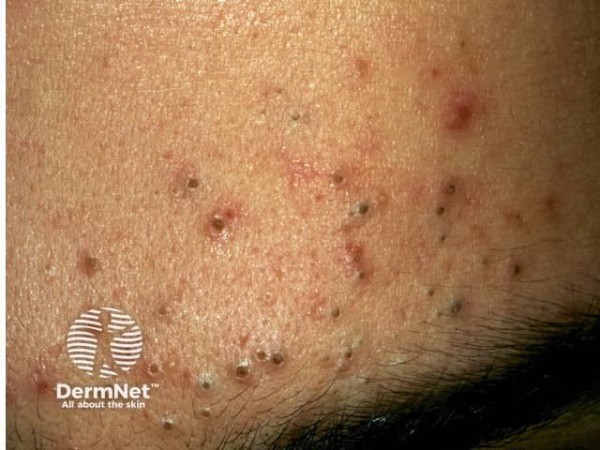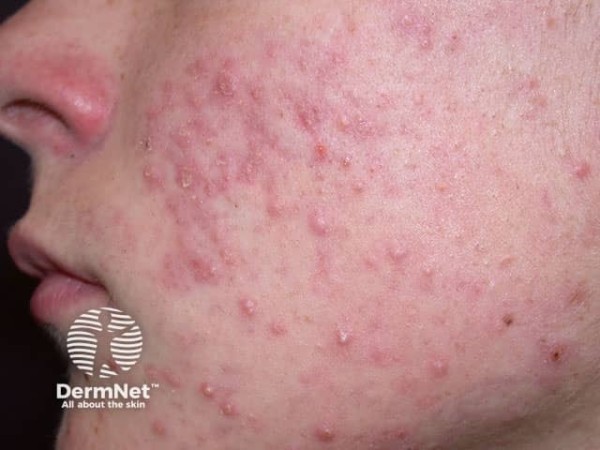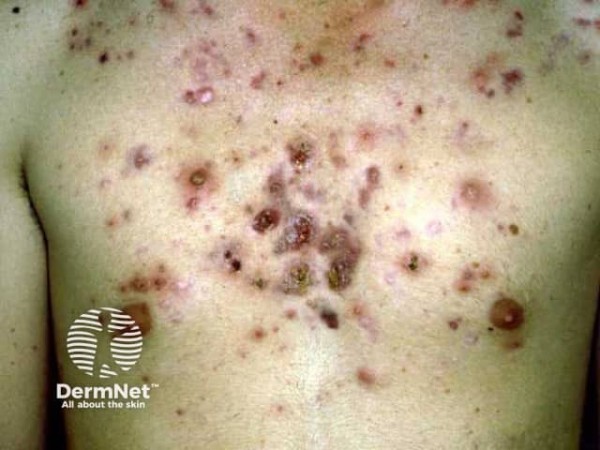Acne
Acne — extra information
Categories:
Follicular disorder
ICD-10:
L70
ICD-11:
ED80.Z
SNOMED CT:
11381005
Follicular disorder
Author: Dr Amanda Oakley, Dermatologist, Hamilton, New Zealand, 2014. Previous contributor: Minor amendment by Ian Coulson, Dermatologist, 2024. Edited by the DermNet content department
Introduction Demographics Causes Clinical features Diagnostic tests Treatment Outlook
What is acne?
Acne is a common chronic disorder affecting the hair follicle and sebaceous gland, in which there is expansion and blockage of the follicle and inflammation. There are several variants.
Who gets acne?
Acne affects males and females of all races and ethnicities. It is prevalent in adolescents and young adults, with 85% of 16 to 18 year-olds affected. However, it may sometimes occur in children and adults of all ages.
What causes acne?
Acne is due to a combination of factors. The exact mechanisms are not fully understood.
Familial tendency Endogenous and exogenous androgenic hormones Acne bacteria Innate immune activation with inflammatory mediators Distension and occlusion of the hair folliclesFlares of acne can be provoked by:
Polycystic ovarian disease Drugs: steroids, hormones, anticonvulsants, epidermal growth factor receptor inhibitors and others Application of occlusive cosmetics High environmental humidity Diet high in dairy products and high glycaemic foods.What are the clinical features of acne?
Acne is often confined to the face but it may involve the neck, chest, and back.
It is characterised by:
Open and closed uninflamed comedones (blackheads and whiteheads) Inflamed papules and pustules In severe acne, nodules and pseudocysts Post-inflammatory erythematous or pigmented macules and scars Adverse social and psychological effects.Severity is classified as mild, moderate, or severe.
Mild acne: total lesion count <30 Moderate acne: total lesion count 30–125 Severe acne: total lesion count >125What tests are necessary for acne?
In most cases, tests are unnecessary. If features are atypical consider:
Skin swabs for microscopy and culture Hormonal tests in females.
Comedonal acne

Acne vulgaris

Nodulocystic acne
See more images of acne:
Acne affecting the back images Facial acne images Steroid acne images.What is the treatment for acne?
Mild acne
Topical anti-acne agents, such as benzoyl peroxide, azelaic acid, and tretinoin or adapalene gel and some antibiotics (clindamycin). New bioactive proteins may also prove successful. Newer topical agents such as clascoterone Low-dose combined oral contraceptive Antiseptic or keratolytic washes containing salicylic acid Light/laser therapyModerate acne
As for mild acne plus a tetracycline such as doxycycline 50–200 mg daily for 6 months or so Erythromycin or trimethoprim if doxycycline intolerant Antiandrogen therapy with long-term cyproterone acetate + ethinylestradiol or spironolactone may be considered in women not responding to low-dose combined oral contraceptive, particularly for women with polycystic ovaries Isotretinoin is often used if acne is persistent or treatment-resistant Intralesional steroid injections can be useful for acute larger acne lesionsSevere acne
Referral to a dermatologist If fever, arthralgia, bone pain, ulcerated or extensive skin lesions, blood count should be arranged and referral is urgent Oral antibiotics are often used in higher doses than normal Oral isotretinoin is usually recommended in suitable patientsWhat is the outlook for acne?
Acne tends to improve after the age of 25 years but may persist, especially in females.Treatment with isotretinoin can lead to long-term remission in many patients.
Bibliography
Reynolds RV, Yeung H, Cheng CE, et al. Guidelines of care for the management of acne vulgaris. J Am Acad Dermatol. 2024;90(5):1006.e1-1006.e30. PubMedOn DermNet
Acne pages Comedo Enlarged pores Facial acne imagesOther websites
Acne, Rosacea, and Perioral Dermatitis — DermNet e-lecture [Youtube] Acne — Medline Plus Acne — emedicinehealth Clinical Guidelines — British Association of Dermatologists Acne: Patient Handouts — The Society for Pediatric Dermatology Patient information: A guide to acne — UpToDate for patients Acne — American Academy of Dermatology Systematic reviews on acne vulgaris — University of NottinghamBooks about skin diseases
Books about the skin Dermatology Made Easy - second edition
Other recommended articles
网址:Acne https://c.klqsh.com/news/view/276938
相关内容
Acne范玮琪演唱会项链争议
朋友圈沙雕俏皮文案,看一次笑一次!
时尚圈动态:销售、展览与新荣誉齐飞
Unisex
